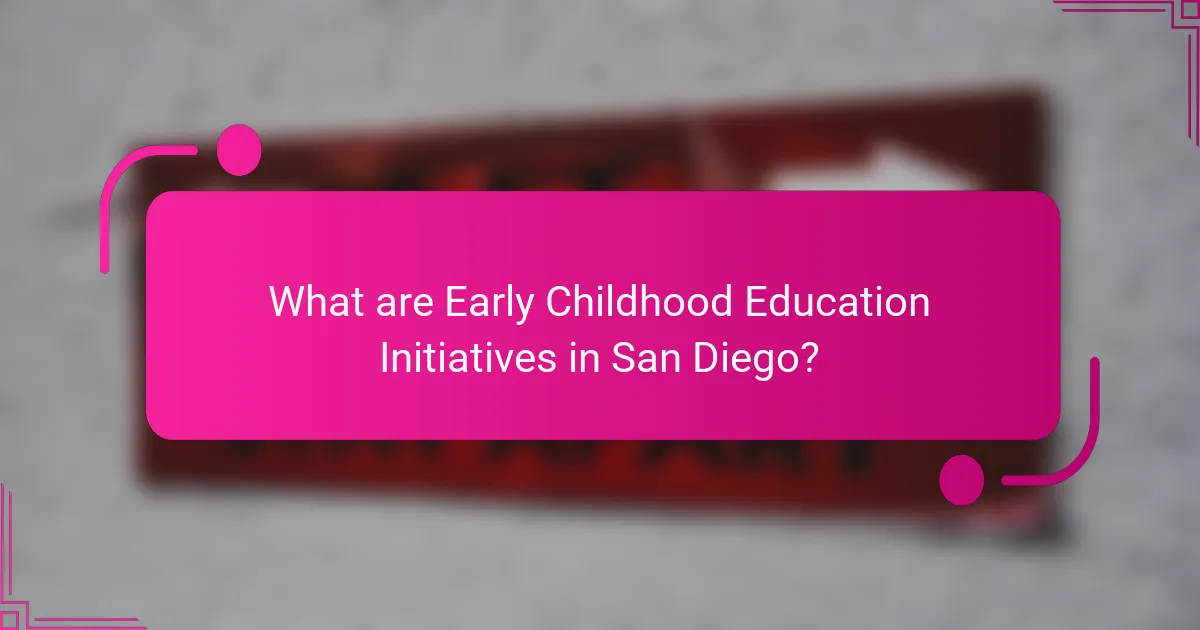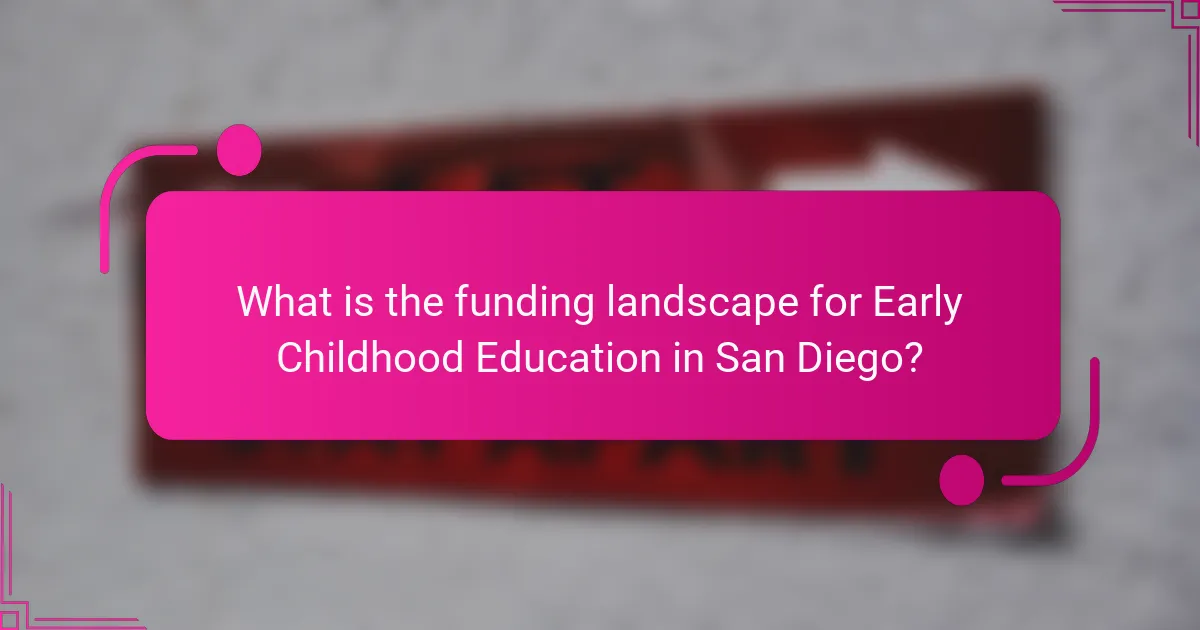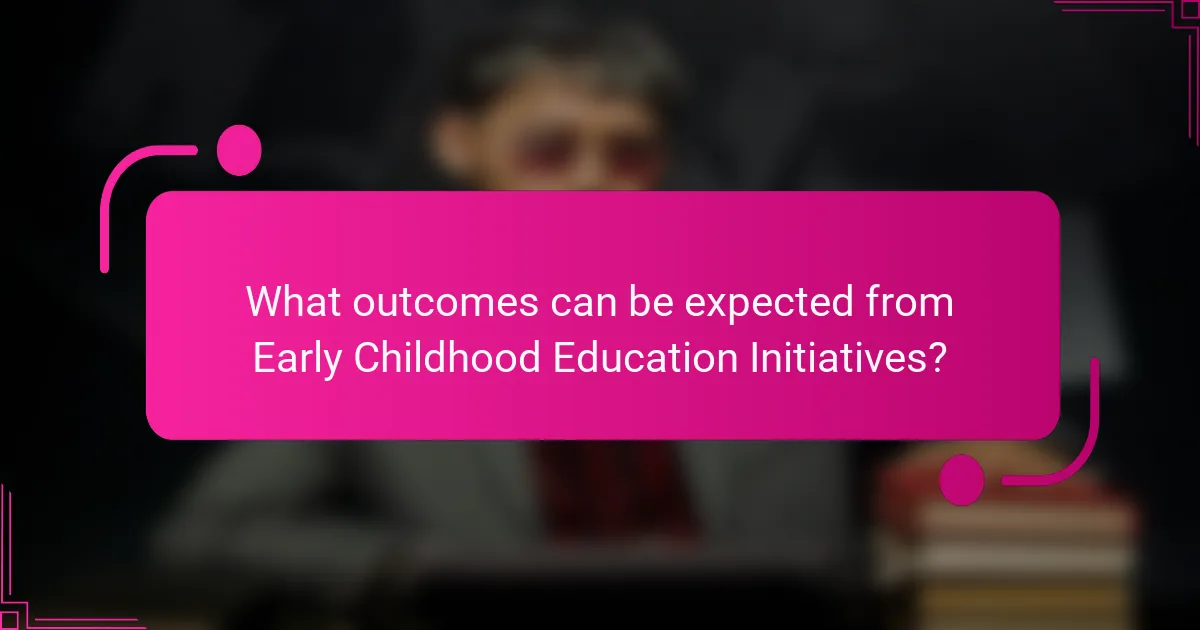
What are Early Childhood Education Initiatives in San Diego?
Early Childhood Education Initiatives in San Diego focus on enhancing educational opportunities for young children. These initiatives include programs like the San Diego County Preschool Quality Rating and Improvement System. This system aims to improve the quality of preschool education. Additionally, the First 5 San Diego initiative promotes early childhood development through funding and resources. These initiatives are supported by local government and community organizations. They aim to provide access to high-quality education for all children. Research shows that early education significantly impacts long-term academic success.
Why are Early Childhood Education Initiatives important for child development?
Early Childhood Education Initiatives are crucial for child development because they provide foundational learning experiences. These initiatives promote cognitive, social, and emotional growth in young children. Research indicates that quality early education can enhance school readiness by significantly improving language and literacy skills. According to the National Institute for Early Education Research, children who participate in high-quality early education programs perform better academically in later grades. Furthermore, these initiatives help in developing critical social skills, such as cooperation and conflict resolution. Evidence shows that children enrolled in early childhood programs are more likely to graduate from high school and pursue higher education. Thus, investing in early childhood education is essential for fostering long-term academic and life success.
What specific skills do these initiatives aim to develop in children?
These initiatives aim to develop critical thinking, social skills, and emotional regulation in children. Critical thinking skills enable children to solve problems and make decisions. Social skills help children interact positively with peers and adults. Emotional regulation allows children to manage their feelings and reactions effectively. Research shows that early childhood education significantly enhances these skills. A study by the National Institute for Early Education Research indicates that quality programs improve cognitive and social development. These skills are foundational for future academic success and personal well-being.
How do these initiatives impact social and emotional development?
Early childhood education initiatives significantly enhance social and emotional development. These programs foster skills such as empathy, cooperation, and self-regulation. Children learn to interact positively with peers and adults in structured environments. Research indicates that children in quality early education settings exhibit better emotional understanding. For instance, a study by the National Institute for Early Education Research found that participants showed improved social skills by 30%. Additionally, these initiatives often include social-emotional learning components. Such components teach children to manage emotions and resolve conflicts effectively. Overall, these initiatives create a strong foundation for lifelong social and emotional health.
What types of Early Childhood Education Initiatives exist in San Diego?
San Diego has various Early Childhood Education Initiatives. These include state-funded preschool programs, like the California State Preschool Program. Additionally, there are nonprofit organizations offering early learning services. Head Start programs are also available for low-income families. The city supports initiatives focusing on parental engagement and community resources. Local school districts provide transitional kindergarten options. Furthermore, there are programs emphasizing social-emotional development. These initiatives aim to enhance school readiness and overall child development.
What are the different programs available for early childhood education?
Various programs are available for early childhood education. These include Preschool Programs, Head Start, Pre-Kindergarten, and Montessori Schools. Preschool Programs typically serve children ages 3 to 5. Head Start focuses on low-income families and provides comprehensive education and support services. Pre-Kindergarten programs prepare children for kindergarten through structured learning. Montessori Schools emphasize child-led learning and hands-on activities. Each program offers unique approaches to support children’s development. Research shows that quality early childhood education enhances cognitive and social skills. Programs like Head Start have proven effective in improving school readiness.
How do these programs vary in approach and methodology?
Early childhood education initiatives in San Diego vary in approach and methodology based on their specific goals and target populations. Some programs emphasize play-based learning, while others focus on structured curricula. Programs may also differ in their use of assessment tools to measure student progress. For example, some initiatives utilize observational assessments, whereas others rely on standardized testing. Additionally, community involvement and parental engagement strategies can vary significantly among programs. Some initiatives actively involve parents in the learning process, while others focus more on direct teacher-student interactions. Funding sources also influence methodologies, with some programs supported by public funding prioritizing accountability measures. These differences in approach and methodology reflect the diverse needs of children and families in the San Diego area.

What is the funding landscape for Early Childhood Education in San Diego?
The funding landscape for Early Childhood Education in San Diego includes various sources such as federal, state, and local government funding. Federal programs like Head Start provide significant financial support for low-income children. State funding includes California’s Proposition 98, which allocates funds specifically for early education. Local initiatives also contribute, with organizations and foundations offering grants and donations. In recent years, San Diego County has emphasized increasing access to quality early childhood programs. Data from the California Department of Education shows a growing investment in pre-K programs to enhance educational outcomes. The combination of these funding sources aims to support diverse early childhood education initiatives in the region.
How is funding allocated to Early Childhood Education Initiatives?
Funding for Early Childhood Education Initiatives is allocated through a combination of federal, state, and local government sources. Federal funding includes programs like Head Start and Child Care Development Block Grants. State funding often comes from specific education budgets and grants aimed at early childhood programs. Local governments may also contribute through budget allocations for community services.
In San Diego, funding is further influenced by local initiatives and partnerships with non-profit organizations. These organizations often seek grants from private foundations to supplement government funding. The allocation process typically involves assessing community needs and program effectiveness.
Data from the National Institute for Early Education Research shows that increased funding correlates with improved educational outcomes. This evidence supports the necessity of adequate funding for successful early childhood education programs.
What sources contribute to the funding of these initiatives?
Funding for early childhood education initiatives in San Diego comes from various sources. These include federal and state government allocations, local government budgets, and private donations. Additionally, grants from foundations and non-profit organizations play a significant role. For instance, the California Department of Education provides funding through specific programs aimed at early childhood education. Local initiatives may also receive support from community fundraising events. This diverse funding landscape ensures the sustainability and growth of educational programs for young children in the region.
How does government policy influence funding levels?
Government policy significantly influences funding levels for early childhood education initiatives. Policies determine budget allocations at local, state, and federal levels. For instance, legislation like the Child Care Development Block Grant sets funding priorities. These policies can either increase or decrease the financial resources available. Additionally, government initiatives often incentivize private investment in early education. This creates a multiplier effect on funding availability. Historical data shows that states with robust early childhood policies receive higher funding levels. In contrast, states lacking such policies often struggle with limited resources.
What challenges do Early Childhood Education Initiatives face in securing funding?
Early Childhood Education Initiatives face significant challenges in securing funding. Limited state and federal budgets often prioritize other areas, leaving early childhood programs underfunded. Additionally, competition for grants and donations is fierce among various social programs. Many initiatives struggle to demonstrate measurable outcomes that attract funding. Stakeholders may lack awareness of the long-term benefits of early education, reducing public support. Economic downturns further impact available resources for funding these initiatives. Furthermore, the reliance on fluctuating philanthropic contributions creates instability in financial planning. These factors collectively hinder the sustainability and growth of Early Childhood Education Initiatives.
What are common obstacles to obtaining funding?
Common obstacles to obtaining funding include lack of awareness, competition for resources, and stringent eligibility criteria. Many organizations struggle to effectively communicate their needs. This leads to potential funders being unaware of available initiatives. Competition for limited funding sources can deter applicants. Funders often have specific requirements that can exclude some programs. Additionally, economic downturns can reduce available funding. According to the National Association for the Education of Young Children, funding for early childhood education is often inconsistent. This inconsistency creates uncertainty for programs relying on grants and donations.
How do economic factors affect funding availability?
Economic factors significantly influence funding availability for early childhood education initiatives. Economic growth typically leads to increased government revenue, allowing for more investment in education. Conversely, economic downturns often result in budget cuts, reducing available funding. Interest rates also affect funding; lower rates can encourage borrowing for educational programs. Inflation impacts the cost of running programs, which may deter funding if expenses rise faster than revenue. Additionally, local economic conditions can impact philanthropic contributions, as donors may have less disposable income during tough times. Overall, the economic landscape directly shapes the resources allocated to early childhood education.

What outcomes can be expected from Early Childhood Education Initiatives?
Early Childhood Education Initiatives lead to improved cognitive and social skills in children. These programs enhance language development and foster emotional regulation. Research shows that children who participate in quality early education are better prepared for school. They often demonstrate higher academic achievement throughout their educational journey. A study by the National Institute for Early Education Research found that children in early education programs are less likely to require special education services. Additionally, these initiatives contribute to long-term economic benefits for communities. For every dollar invested, there is an estimated return of $4 to $9 in societal benefits. These outcomes emphasize the critical role of early childhood education in child development and community well-being.
How do these initiatives measure success and effectiveness?
These initiatives measure success and effectiveness through various metrics. They evaluate student progress using standardized assessments. Attendance rates are also monitored to gauge engagement. Parent and community feedback is collected to assess satisfaction. Additionally, long-term outcomes like school readiness and academic achievement are analyzed. Data from local educational agencies provides insights into performance trends. Research indicates that these measures correlate with improved educational outcomes. For example, studies show that early intervention leads to higher graduation rates.
What metrics are used to evaluate educational outcomes?
Metrics used to evaluate educational outcomes include standardized test scores, graduation rates, and student attendance. Standardized test scores provide measurable data on student performance in various subjects. Graduation rates indicate the percentage of students completing their education within a specified time frame. Student attendance reflects engagement and can correlate with academic success. Additional metrics may include assessments of social-emotional development, teacher evaluations, and parental feedback. These metrics collectively offer insights into the effectiveness of educational programs and initiatives.
How do participant outcomes compare to those of non-participants?
Participants in early childhood education initiatives typically show better developmental outcomes compared to non-participants. Research indicates that children who engage in these programs often achieve higher academic performance. They also exhibit improved social skills and emotional regulation. For instance, a study by the National Institute for Early Education Research found that participants scored significantly higher on standardized tests. Additionally, these children are less likely to require special education services later in their schooling. The benefits extend beyond academics, as participants often display enhanced readiness for school. Overall, early childhood education initiatives yield measurable advantages for children compared to their non-participating peers.
What long-term benefits do Early Childhood Education Initiatives provide?
Early Childhood Education Initiatives provide long-term cognitive and social benefits for children. Research indicates that children who participate in these programs demonstrate improved academic performance throughout their schooling. They are more likely to graduate high school and pursue higher education. Additionally, these children show enhanced social skills, leading to better interpersonal relationships. Studies have found that early education reduces the likelihood of behavioral issues in later years. Furthermore, these initiatives contribute to economic benefits, as they can lower future societal costs related to crime and welfare. According to the National Institute for Early Education Research, every dollar invested in early childhood education can yield a return of up to $7 in economic benefits.
How do these initiatives impact future educational attainment?
Early childhood education initiatives significantly enhance future educational attainment. These programs provide foundational skills crucial for academic success. Children engaged in quality early education demonstrate improved literacy and numeracy skills. Research indicates that students from early education backgrounds are more likely to graduate high school. According to a study by the National Institute for Early Education Research, children in high-quality preschool programs score higher on standardized tests. Additionally, these initiatives foster social and emotional development, contributing to better classroom behavior. Enhanced educational outcomes lead to increased opportunities for higher education and career advancement. Overall, early childhood education initiatives create a strong base for lifelong learning.
What role do they play in community development and economic growth?
Early childhood education initiatives play a critical role in community development and economic growth. They provide foundational skills essential for children’s future academic success. Improved educational outcomes lead to a more skilled workforce. A skilled workforce attracts businesses and stimulates local economies. Studies show that every dollar invested in early education yields significant returns, often estimated at $7 to $10 per dollar. This return comes from reduced need for social services and increased tax revenues. Furthermore, these initiatives foster community cohesion and support for families. Engaging parents in education strengthens community ties and promotes overall well-being.
What best practices can enhance the effectiveness of Early Childhood Education Initiatives?
Implementing evidence-based curricula enhances the effectiveness of Early Childhood Education Initiatives. These curricula are designed based on research about child development. Training educators in these methods ensures they can effectively deliver the content. Engaging families in the educational process fosters a supportive learning environment. Regular assessments of children’s progress help tailor instruction to individual needs. Collaboration with community resources expands support services for children and families. Providing professional development for educators keeps them updated on best practices. These strategies are supported by studies showing improved outcomes for children in quality early education programs.
Early Childhood Education Initiatives in San Diego focus on enhancing educational opportunities for young children through various programs aimed at improving school readiness and child development. Key initiatives include the San Diego County Preschool Quality Rating and Improvement System and the First 5 San Diego initiative, which provide resources and funding for early education. The article explores the importance of these initiatives for cognitive, social, and emotional growth, as well as the challenges in securing funding and the long-term benefits they offer to individuals and communities. It also examines the diverse types of programs available, their methodologies, and the metrics used to measure their effectiveness.